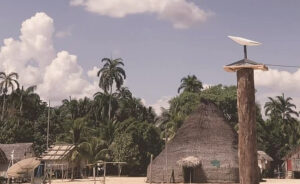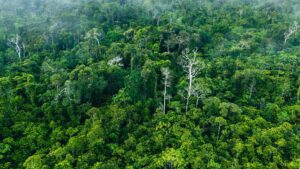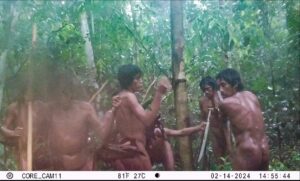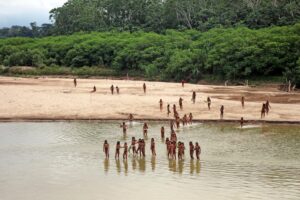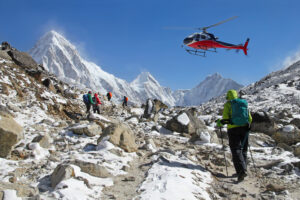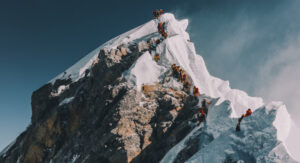By the time you read this blog we should be on our way to Rio Jutaí – the last of the major tributaries of the Brazilian Amazon basin. ”
Pete Casey is following the mighty Amazon river in the most ambitious and intimate way possible: walking, sometimes swimming every inch of the Amazon from sea to source, and in the process interacting with its people and its wildlife face to face at ground level. Here is his last post:
Bridge Over Troubled Waters
MARCH 20, 2018 BY PETE Casey
By the time you read this blog we should be on our way to Rio Jutaí – the last of the major tributaries of the Brazilian Amazon basin.
Before we left Juruá, I sent photos for this blog to Clive Maguire in Manaus. I then managed to write some of the blog via a batch of Garmin Inreach messages sent to Clive from the jungle. He then pieced the blog together and published it for me. Thanks Clive!
The west side of Juruá City was in seasonal flood, and in order to keep to the rules I had set myself, I needed to cross 25km of rivers and flooded forest to get to terra firma (see NASA satellite image below) After looking at various ideas and studying the topography, I came up with a viable plan. We walked the 8km of muddy road south of Juruá until we reached the river, then despite the nay-sayers in the city, I made the swim 18km down the wide, fast-moving river with a small canoe escort. From the a suitable westerly point, we then walked across 7km of tangled flooded forest, putting our packs in a small wooden canoe we had borrowed and – with the help of Zebete (the canoe owner) – pulling and pushing it through the forest. The plan was to get to the bank of the Rio Breu and dry higher ground the same day, but at 1.5km away from the Breu, the canoe got wedged in the tangled trees and we couldn’t lift it as is was too heavy and the forest too tangled. There was only one option left, and we reluctantly decided to leave the canoe and all our gear behind and wade and cut a path to the Rio Breu, in order to complete this important section. Later, we returned to the canoe, but by the time we got back it was late in the day and I decided we would have to make camp in the flooded forest and sleep above the water.
The following morning we backtracked through the flooded forest again to return to the Juruá River. We could not have done anything else, as I had the GPS and maps to do it, and canoe owner Zebete could simply not have managed it alone.
I decided that rather than traversing the flooded forest across to the Breu for a third time, we would go back to the city with Zebete in the canoe, then return on the connecting lakes and little rivers the next day to the point we had walked to on the other side of the flooded forest. We could then continue walking along the dry bank of the Breu until we reached the location I had marked on the opposite bank where I planned to start the long and arduous crossing to Rio Jutaí.
When we finally reached that point, we accepted an offer to pass the night in a floating house on the bank of the Rio Breu. The next day we were to say goodbye to Zebete and get on our way… but sod’s law kicked in, and that night the shivers came on and I started coughing. By the following morning I was so sick I could hardly get out of my hammock to get to the medical kit. It was bad enough that I wondered if I had finally contracted malaria. Once again, I had to take the difficult decision to return to the city, although it was fortunate that Zebete hadn’t yet left.
It was just as well we returned, as I had the worst fever I have had in years. It turned out not to be malaria, or any of the other obvious tropical illnesses, but there is no way we could have started walking to Rio Jutaí with full packs. I’ve never been one to lie down when I’m ill, but on this occasion the fever was such that I literally could not get off my bed for several days. I lay there in the little hotel in a pool of sweat, drifting in and out of consciousness and waiting for the fever to lose its grip on me. When it did, after yet another course of antibiotics, 12 days had passed. We were ready to continue.
They say that a rolling stone gathers no moss, and it’s certainly true that as we roll into and away from so many brief encounters, there is little emotional baggage created. However, when I spend more time than expected somewhere, it is sometimes it’s a little emotional. A handful of the locals had eagerly helped us with everything from offering medication, ferrying us about on motorbikes and canoes, cooking us the best BBQ and chicken I’ve ever tasted, telling us stories from the city’s past, and, at the end of my convalescence, plying us with ice cold beer and dragging us onto the dance floor at an all-night carnival. A real roller coaster ride for my feelings.
On the morning of our departure, we said our goodbyes and walked down to the waiting canoe on the banks of the great Juruá River with our enormous packs. I had something of a heavy heart at the thought of leaving our new friends, but I knew had to focus now. I needed to move on and try to shake off that moss we had gathered. And I will, although all of the people, places and experiences from this journey will surely be with me for life.
I must give sincere thanks
to Everaldo for deciding to return, quite unasked, to walk with me on this leg
after my unsuccessful search for a new guide. His ever-present optimism helped
me see a way across one of the most daunting sections of this expedition to
date. My meticulous (obsessive?) planning is one thing, but it was due in no
small part to Emerald’s optimism, knowledge and support that we managed to find
a bridge over troubled waters.
Check original post in ascentoftheamazo.com:& https://www.ascentoftheamazon.com/2018/03/bridge-over-troubled-waters/
previous stories:
https://www.ascentoftheamazon.com/2018/02/the-emerald-city/ and& https://explorersweb.com/From-the-end-of-the-Amazon-to-the-beginning-On-foot-and-swimming-2018-01-19-64361& & &
“

